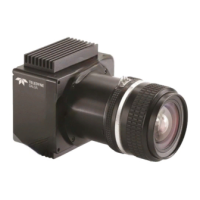48 Piranha 2 User’s Manual
03-032-00493-14 Teledyne DALSA
Light Sources
Keep these guidelines in mind when setting up your light source.
• LED light sources are relatively inexpensive, provide a uniform field, and longer life
span compared to other light sources. However, they also require a camera with
excellent sensitivity, such as the Piranha 2 camera.
• Halogen light sources generally provide very little blu e relative to IR.
• Fiber-optic light distribution systems generally transmit very little blue relative to IR.
• Some light sources age; over their life span they produce less light. This aging may
not be uniform—a light source may produce progressively less light in some areas of
the spectrum but not others.
Filters
CCD cameras are extremely responsive to infrared (IR) wavelengths of light. To prevent
infrared from d istorting the im ages you scan, u se a ―hot mirror‖ or IR cutoff filter that
transmits visible wavelengths but does not transmit wavelengths over 750nm. Examples
are the Schneider Optics™ B+W 489, w hich includ es a mou nting ring, the CORION™ LS-
750, which does not include a mounting ring, and the CORION™ H R-750 series hot
mirror.
Lens Modeling
Any lens surrounded by air can be modeled for camera purposes using three primary
points: the first and second principal points and the second focal point. The primary
points for a lens should be available from the lens data sheet or from the lens
manufacturer. Primed quantities denote characteristics of the image side of the lens. That
is, h is the object height and h
is the image height.
The focal point is the point at which the image of an infinitely distant object is brought to
focus. The effective focal length (f
) is the distance from the second principal point to the
second focal point. The back focal length (BFL) is the distance from the image side of the
lens surface to the second focal point. The object distance (OD) is the distance from the first
principal point to the object.
Figure 11. Primary Points in a Lens System
Magnification and Resolution
The magnification of a lens is the ratio of the image size to the object size:

